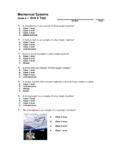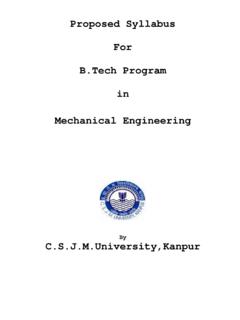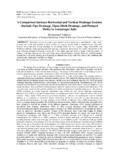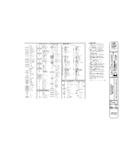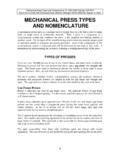Transcription of How to Calculate the Mechanical Advantage of hauling …
1 Special thanks to Reed Thorne, Ropes that Rescue, Sedona, Arizona, By Tim Fox &Mick HoltonHow to Calculate theMechanical Advantageof hauling systems2ndEdition How to Calculate the Mechanical Advantage - 2 - By Tim Fox & Mick Holton of hauling systems, 2nd edition. Thanks to Reed Thorne Types of hauling Systems There are three types of hauling systems: movingpulleyanchorhaulinglineloadstation arypulley Figure 1 1. Simple hauling Systems A simple hauling system is when all moving pulleys are attached to the load. 2. Compound hauling Systems A compound hauling system is a simple hauling system that is pulling on the end of another simple hauling system . In this example (Figure 2) the two separate systems are joined using a prussic hitch. A simple systempulling onanothersimple systemprussichitch Figure 2 LoadtravelingupPulleytravelingdown Figure 3 3.
2 Complex hauling Systems A complex hauling system is created when you have a moving pulley that is traveling in the opposite direction to the load. How to Calculate the Mechanical Advantage - 3 - By Tim Fox & Mick Holton of hauling systems, 2nd edition. Thanks to Reed Thorne There are two methods that can be used to Calculate the Mechanical Advantage of a hauling system . One is called Counting the Lines method and the other is called Adding the Tensions method. 1. Counting the Lines Method Simple hauling Systems To Calculate the Mechanical Advantage of a simple Mechanical Advantage hauling system using the counting the lines method all you have to do is: + Starting at the hauling line, count the number lines that are attached directly to the load or attached to the pulley that is attached to the load.
3 This will tell you the Mechanical Advantage of the system . 12 Figure 4 Cover the top half of the hauling system and count the number of lines attached to the load pulley. In this example (figure 4) the Mechanical Advantage is 2:1 12 Figure 5 In this example (figure 5) the hauling line is not attached directly to the load. If you cover the top section of the hauling system you can see that only two lines are attached directly to the load pulley. The Mechanical Advantage of this system is still 2:1 How to Calculate the Mechanical Advantage - 4 - By Tim Fox & Mick Holton of hauling systems, 2nd edition. Thanks to Reed Thorne Compound hauling Systems You can use the Counting the Lines method to Calculate the Mechanical Advantage of compound or multiplying systems. (a)(b) Figure 6 + See the example in figure 6 Draw a line at the point of attachment of the prussic hitch.
4 This helps by keeping the two systems separate. See figure 6(a) and 6(b) Starting at the hauling line Calculate the Mechanical Advantage as follows: (a) is 3:1 Figure 6 (a) (b) is 2:1 Figure 6 (b) = (a) x (b) = (3:1) x (2:1) = 6:1 The Mechanical Advantage of the hauling system in figure 3 is 6:1 How to Calculate the Mechanical Advantage - 5 - By Tim Fox & Mick Holton of hauling systems, 2nd edition. Thanks to Reed Thorne 2. Adding the Tensions Method 100kg100kg200kgstationarypulley Figure 7 100kg100kg200kgpulleymoveswithload Figure 8 + To better understand the Adding the Tensions Method you will need to learn a basic principle. If a force is being applied to one side of a pulley the same force will be applied on the other side of the pulley.
5 In simple terms if there is a 100kg load on one side of a pulley there must be another 100kg load on the other side of the pulley and there will be a 200kg load on pulley anchor. See figures 7 and 8. Simple hauling Systems To Calculate the Mechanical Advantage of a simple hauling system using the adding the tensions method, all you have to do is: MA = 3:1(1)(1)(1)(3)123 Figure 9 Look at the amount of tension on each part of the simple hauling system in figure 9. Each part is numbered 1, 2 and 3. The amount of tension is indicated by the use of brackets. If you apply one unit of tension to the hauling line, numbered 1, there will also be one unit of tension on lines 2 and 3. This is due to the basic principle that we learned earlier. All three lines are attached to the load pulley, therefore there is a total of three units of tension on the load. The Mechanical Advantage is 3:1 + When using the adding the tensions method you must add the tensions of all the lines that are attached to the load or the pulley that is attached to the load.
6 How to Calculate the Mechanical Advantage - 6 - By Tim Fox & Mick Holton of hauling systems, 2nd edition. Thanks to Reed Thorne Compound hauling Systems To Calculate the Mechanical Advantage of a compound or multiplying hauling system using the adding the tensions method, all you have to do is: o Always start at the hauling line and look at the amount of tension you are applying to that part of the system . Remembering the basic principle that you learned earlier, you can now work out how many units of tension are on each part of the system . o Using the example below (figure 10), if you apply one unit of tension to the hauling line at point (a) there will be one unit of tension at point (b) and one unit of tension at point (c). o Stop when you reach a prussic hitch. o There is one unit of tension on either side of the pulley attached to the prussic loop, therefore there must be two units of tension on the prussic loop (d).
7 O There is one unit of tension at point (c) and two units of tension on the prussic loop (d) therefore there are three units of tension just below the prussic loop (e). o Remembering the basic principle again, if there are three units of tension at point (e) there must be three units of tension on the other side of the pulley at point (f). o We now add the tensions being applied to the load pulley, (e)+(f)=(g) or 3+3 = 6. You started by applying a force of 1 to the hauling line and ended up with a force of 6 at the load pulley, therefore the Mechanical Advantage is 6:1. MA = 6:1(a)1(b)1(c)1(d) 2(e) 3(g) 6(f)3 Figure 10 IN SUMMARY (a) is the haul line with 1 unit of force applied. (a), (b) & (c) are all subjected to the same force up until the prussic knot. (d) is the prussic loop attaching a pulley to the main line. The force at (d) = force at (a) + force at (b) (e) is a part of the main line, just under the prussic that is now subjected to an increased force.
8 The force at (e) = force at (c) + force at (d) (g) is the attachment to the load and is subjected to an even greater force. The force at (g) = force at (e) + force at (f) The final force at (g) = 6 units when we apply a single unit of force at (a) therefore we have a 6:1 + When using the adding the tensions method you must add the tensions of all the lines that are attached to the load or the pulley that is attached to the load. Do not include the tensions that are in the lines that are not attached to the load or load pulley. How to Calculate the Mechanical Advantage - 7 - By Tim Fox & Mick Holton of hauling systems, 2nd edition. Thanks to Reed Thorne You cannot use the Counting the Lines method to Calculate the Mechanical Advantage of complex hauling systems but it is an easy calculation when using the Adding the tensions method.
9 Complex hauling Systems To Calculate the Mechanical Advantage of a complex hauling system using the adding the lines method, all you have to do is: o Always start at the hauling line and look at the amount of tension you are applying to that part of the system . Remembering the basic principle that you learned earlier, you can now work out how many units of tension are on each part of the system . o Using the example below (figure 11), if you apply one unit of tension to the hauling line at point (a) there will be one unit of tension at point (b) and one unit of tension at point (c). o Stop when you reach a prussic hitch. o There is one unit of tension on either side of the pulley attached to prussic loop (d) therefore there must be two units of tension on the prussic loop. There is also one unit of tension on either side of the pulley attached to prussic loop (e) therefore there must be two units of tension on the prussic loop.
10 (a)1(b)1(c)1(d) 2(e) 2(f) 3(g)3(h) 5(j) 10(i)5MA = 10:1 Figure 11 o There is one unit of tension at point (c) and two units of tension on prussic loop (d) therefore there are three units of tension just above the prussic loop at point (f). o There is now 3 units of tension on the line a point (f) therefore there must also be 3 units of tension on the other side of the pulley at point (g). o There are 3 units of tension at point (g) and 2 units of tension on prussic loop (e) so we add those tensions giving us 5 units of tension at point (h) below the prussic hitch. o There are 5 units of tension at point (h) so there must be 5 units of tension on the other side of the pulley at point (i). o You now add the tensions being applied to the load pulley, (i)+(h)=(j) or 5+5 = 10. You started by applying a force of 1 to the hauling line and ended up with a force of 10 at the load pulley, therefore the Mechanical Advantage is 10:1 + When using the adding the tensions method you must add the tensions of all the lines that are attached to the load or the pulley that is attached to the load.

